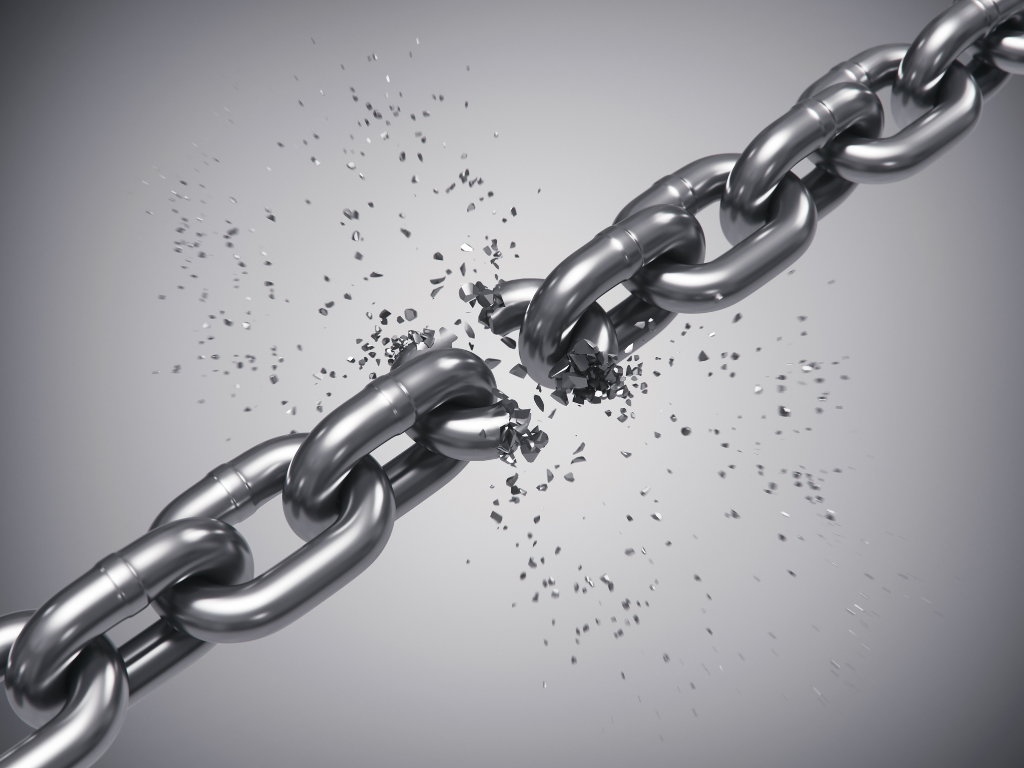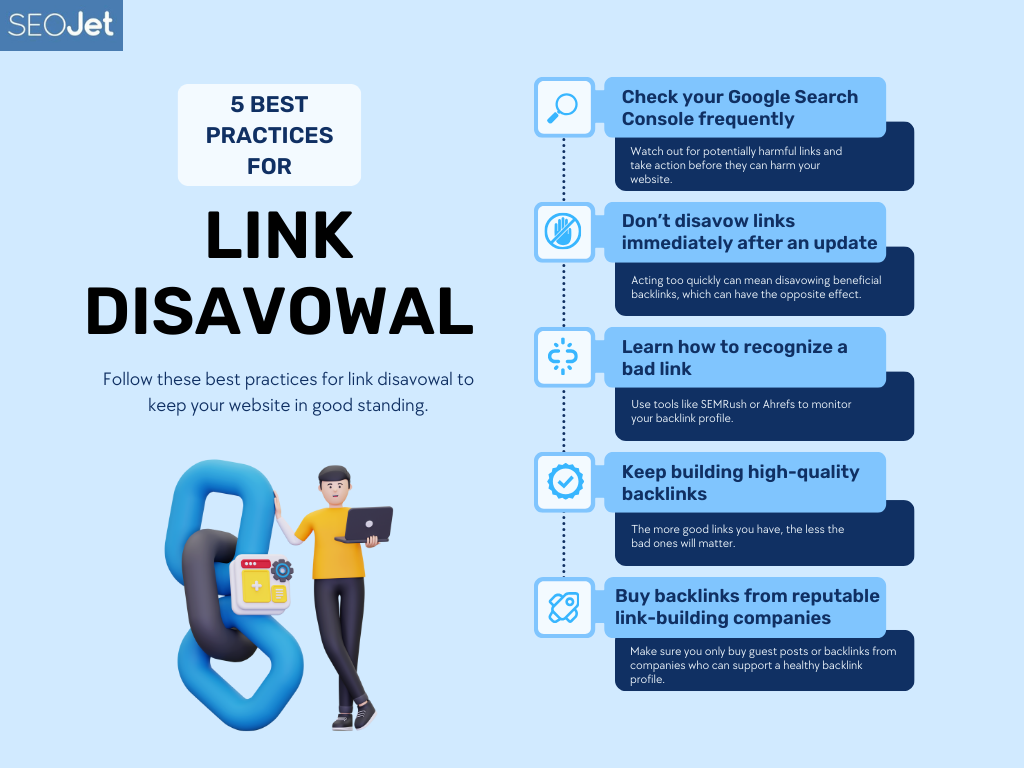How a Technical SEO Audit Can Boost Your Business
How a Technical SEO Audit Can Boost Your Business Ever feel like you’re doing everything
Home » When to Disavow Links (Because Not All Links are Good Links)

How a Technical SEO Audit Can Boost Your Business Ever feel like you’re doing everything
4 Takeaways from the Google API Leak and What They Mean for SEO Google has
How to Use Link Insertions for Better SEO Link insertions are one way to build
Knowing when to disavow links is just as important as knowing how to acquire them in the first place. You’ve spent good money and countless hours building a solid backlink strategy. The last thing you want is for one bad link to undo all that effort.
But when you do get a spammy link, you might not want to disavow it — at least not right away.
Here’s the rundown on link disavowal and how you can protect your backlink profile.
Disavowing a link is like kicking out that inappropriate party crasher to preserve the fun (and your reputation). In the world of SEO, you can tell search engines like Google to ignore a backlink. This way, it has no impact on your rankings or your online reputation.
Google has a dedicated disavow tool that lets you specify which links to ignore. You will need to make a list of the links to disavow, format them appropriately, and upload them to the disavow links tool page.
Some links can be spammy or downright harmful. Telling algorithms to ignore them ensures that only quality, safe, and relevant links are associated with your website.
It’s flattering to receive a backlink you didn’t pay for. Since backlinks are one of the biggest SEO helpers, it’s natural to think that every link can help you look better to the algorithms.
But you might be better off disavowing that link if one or more of the following apply:
Google may send you a manual action if you have too many low-quality links pointing toward your website. This is the number one reason why you should disavow a backlink.
Google may penalize websites that have poor-quality links or when it suspects you’re using link schemes. Signs that may warrant a penalty include:
Likewise, you want to avoid these same criteria when linking from your website to other sites. You can get hit with a penalty if you’re linking to bad websites, link swapping with others, or other poor link-building practices.
First things first: Try to remove those links on your own. You may be able to resolve the issue without having to go through the disavowal process.
Google Search Console may give you a heads up that something isn’t right. If you receive such a message, you might want to disavow links before they become problematic.
Go to Google Search Console > Security & Manual Actions > Manual Actions. Here you can see if any issues have been detected. You can also search for toxic backlinks that might pose a risk later.
If Google sends you a manual action, it means a human has reviewed the links in question and believe they go against Google’s community guidelines.
If you do go through the disavowal process, make sure you also request a reconsideration. This signals to Google that you have taken the corrective steps and aim to get back in good standing.
You can’t always control who links to you and how they do it. But if you receive a link you don’t like, there are some steps you can take to have it changed or removed. And truthfully, Google expects you to do these things before using the disavow tool.
Some optionsinclude:
If you’ve tried to have the link removed to no avail, you should still exercise caution when using the disavow method.
Overusing this tool can send Google the wrong message. But it also might negatively affect your SEO. The links causing you harm might be easy to spot, but you also risk disavowing links that are actually helpful.
Think of link disavowal as Marie Kondo-ing your digital space. By decluttering toxic links, you ensure Google sees only the good stuff when ranking your site.
Bad backlinks can harm your SEO in several ways:
Not only will Google rank you lower in search results, but your website visitors might form the wrong impression. Seeing your content alongside low-quality sites could erode their trust, leading to higher bounce rates and less traffic — both of which can negatively affect your SEO.
No reputable websites wants to be associated spammy sites and poor backlink choices. In some cases, you’ll have to bite the bullet because the disavow tool isn’t the best option.
To offset the effects of poor quality links that you can’t disavow, focus on building as many good backlinks as possible. This helps you increase the ratio of good to bad backlinks and avoid the hassle of using the disavow tool.
In a perfect world, reputable websites would willingly link to you, using proper anchor text and sending relevant traffic your way. But in the real world, it doesn’t always happen this way. Anyone can link to anyone, which means you may end up with some links that aren’t good for business.
Or worse, they can damage your link-building profile and send your SEO in the wrong direction.
But just because you get a spammy or low-quality link doesn’t mean you should immediately disavow it.
Remember, anyone can link to anyone on the internet. Google knows this, so you can assume there’s a little bit of a safety net built into its rankings decisions.
The truth is, Google’s disavow tool is a last resort. It’s not meant to be a preventative measure or a silver bullet for bad links.
Google says it best: “This is an advanced feature and should only be used with caution. If used incorrectly, this feature can potentially harm your site’s performance in Google Search results.”
If your backlink doesn’t fit one of the reasons listed above, it’s best not to disavow the link.

There’s a difference between bad backlinks and those that cause actual harm to your website. It’s important to know the difference between the two and not immediately rush to disavow them.
Follow these best practices for link disavowal to keep your website in good standing.
Most importantly, monitor your SEO after disavowing a link. Watch how your rankings change to ensure you made the right call.
Knowing when to disavow links is a crucial piece of SEO. But a better approach to avoid gaining links that you need to disavow. You can minimize your chances by focusing on quality backlinking services from proven services like SEOJet.
SEOJet powers your backlinks with data, including optimizing anchor text ratios, choosing best-fit publications, and conducting competitor analysis. We’ll help you craft the ideal backlink profile that gets you noticed by Google for the right reasons.
Watch our demo to learn more!